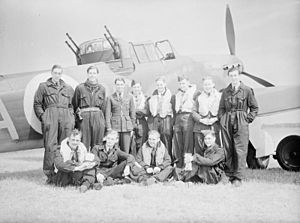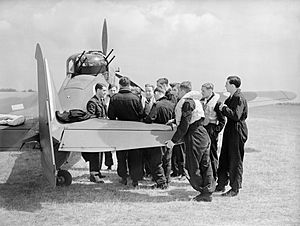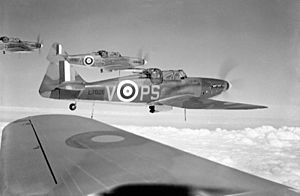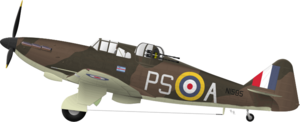Philip Hunter (RAF officer) facts for kids
Quick facts for kids
Philip Hunter
|
|
|---|---|

Phil Hunter, standing third from left, with his squadron c.1940
|
|
| Born | 11 April 1913 Frimley, Surrey |
| Died | 24 August 1940 (aged 27) English Channel |
| Allegiance | United Kingdom |
| Service/ |
Royal Air Force |
| Years of service | 1931–1940 |
| Rank | Squadron Leader |
| Service number | 32081 |
| Unit | No. 25 Squadron RAF |
| Commands held | No. 264 Squadron RAF |
| Battles/wars | Second World War |
| Awards | Distinguished Service Order Mentioned in Despatches |
Philip Hunter (born April 11, 1913 – died August 24, 1940) was a brave pilot in the Royal Air Force (RAF) during the Second World War. He was a skilled leader and was known as a "flying ace" because he shot down many enemy planes. He received a special award, the Distinguished Service Order, for his amazing leadership. He helped destroy 38 enemy aircraft in just two missions near Dunkirk in May 1940. Sadly, he was killed while leading his squadron during the Battle of Britain.
Contents
Early Life and Education
Philip Hunter was born in Frimley, a town in Surrey, England. His parents were Captain Albert and Clare Hunter. Philip went to school at King's School, Canterbury for a few years. He also studied at Rosslyn House in Felixstowe and Bishop Stortford School.
Joining the Royal Air Force
Philip Hunter joined the Royal Air Force when he was young. He trained to be a pilot at the Royal Air Force College Cranwell. On September 11, 1931, he became a probationary pilot officer. He finished his flight training at No. 5 Flying Training School.
Early Flying Career
On August 29, 1932, Philip joined No. 25 Squadron RAF. They flew Hawker Fury Mark I planes from RAF Hawkinge. He was officially confirmed as a pilot officer on September 11, 1932. Later, in February 1933, he moved to No. 6 Squadron RAF in Egypt. There, he flew Fairey Gordon light bombers. He was promoted to flying officer in April 1933.
Rising Through the Ranks
Philip continued to advance in the RAF. He became a flight lieutenant in April 1936. He then returned to England and worked at the Royal Air Force College Cranwell. He also became a Senior Instructor at the Central Flying School. On December 1, 1938, he was promoted to squadron leader. This was a very important leadership role. His story is now part of a book series called "Fighter Leaders." His old flight logbook and medals are kept at the Kent Battle of Britain Museum.
Wartime Service and Leadership
When the Second World War began, there was a great need for strong leaders. Philip Hunter was chosen to command No. 254 Squadron RAF in October 1939. This squadron flew Bristol Blenheim twin-engine fighter planes. He led this squadron until January 1940.
Leading No. 264 Squadron
In March 1940, Philip became the commanding officer of No. 264 Squadron RAF. This squadron flew a unique fighter plane called the Boulton Paul Defiant. This plane had its main guns in a turret at the back. An air gunner sat in the turret and fired the guns. This was different from most fighters, which had guns in the front.
One of his flight commanders was Nicholas Gresham Cooke. Philip's regular air gunner was Frederick Harry King. Early on, German pilots often mistook the Defiant for a Hawker Hurricane. They would attack from behind, which was a blind spot for a Hurricane. But for the Defiant, this meant flying right into the gunner's fire!
Successes Over Dunkirk
On May 12, 1940, Philip and his team shot down a Junkers Ju 88 bomber near the Dutch coast. On May 27, they shot down a Messerschmitt Bf 109. They also helped other Defiants destroy another enemy plane over Dunkirk. The next day, May 28, they shot down two more Bf 109s.
The biggest successes for 264 Squadron happened on May 29, 1940. They fought two major battles that day. In total, they shot down an amazing 38 enemy aircraft! During the first patrol over the Dunkirk beaches, Philip and King shot down a Bf 109. They also destroyed a twin-engine plane and a Ju 87 dive bomber. On May 31, 1940, they shot down another Bf 109 and a Heinkel He 111. This brought their personal score to nine confirmed victories.
After the Dunkirk evacuation was complete, German pilots learned how to fight against the Defiant. This made the Defiant very vulnerable in daylight battles. The months after Dunkirk were spent rebuilding the squadron. They had lost many planes and pilots.
Death in Action
The end of August 1940 was a very difficult time for 264 Squadron. From August 24 to 28, the squadron suffered heavy losses. On August 24, Philip Hunter was flying Defiant N1535. He was fighting against a group of Ju 88s that had just bombed RAF Manston. His plane was last seen chasing an enemy bomber out to sea. Philip Hunter and his air gunner, Frederick Harry King, did not return. They were both killed in action.
Awards and Recognition
- Distinguished Service Order (DSO) (June 14, 1940): Philip Hunter was awarded this high honor for his bravery and leadership. The official statement said:
In May 1940, under the leadership of Squadron Leader Hunter, his squadron shot down thirty-eight enemy aircraft during the course of two patrols. He personally destroyed three of that number. His brilliant leadership as well as his example and courage are of the highest standard.
- Mentioned in Despatches (January 1, 1941): This is another recognition for brave actions in battle.
See also
- List of World War II flying aces




